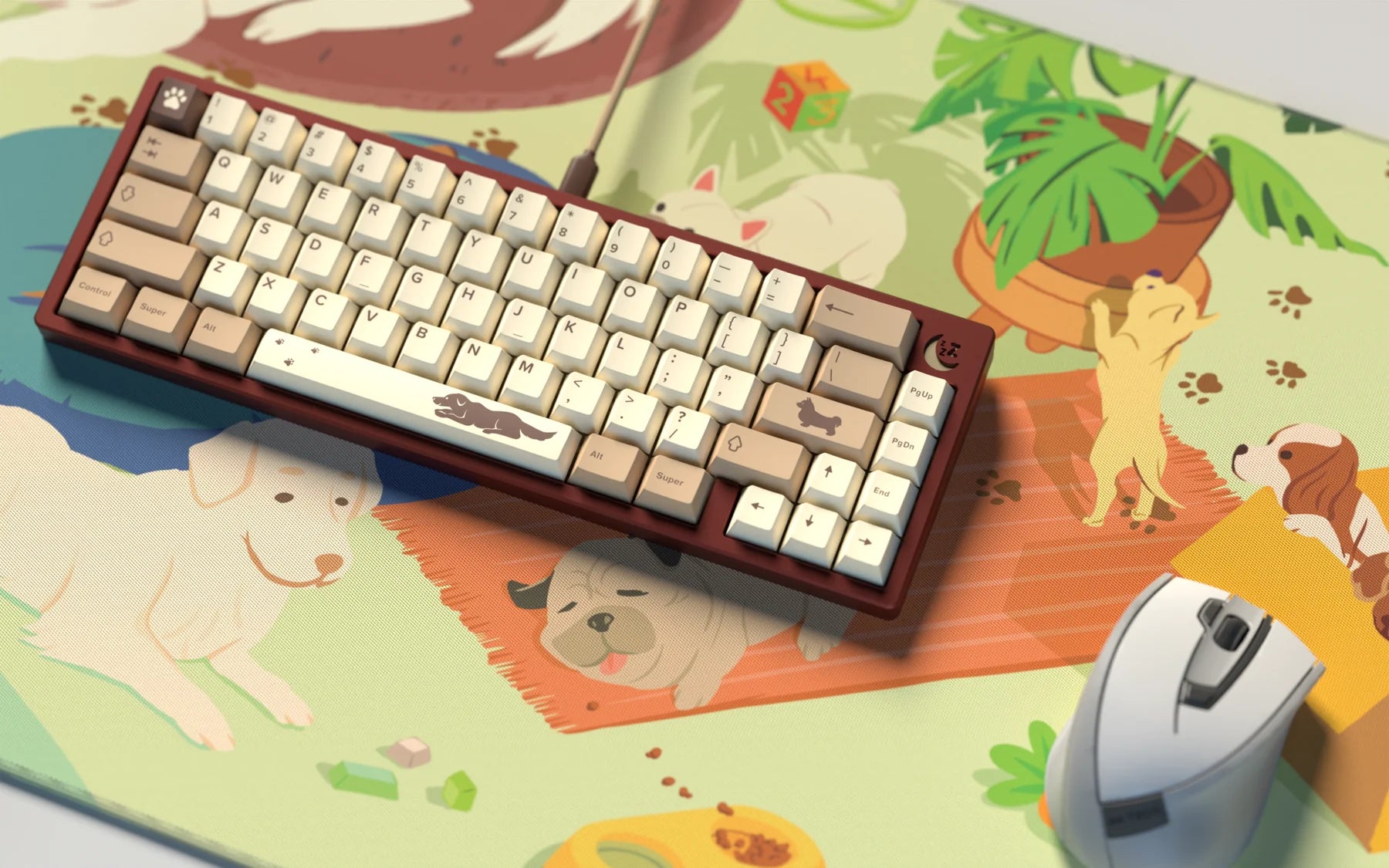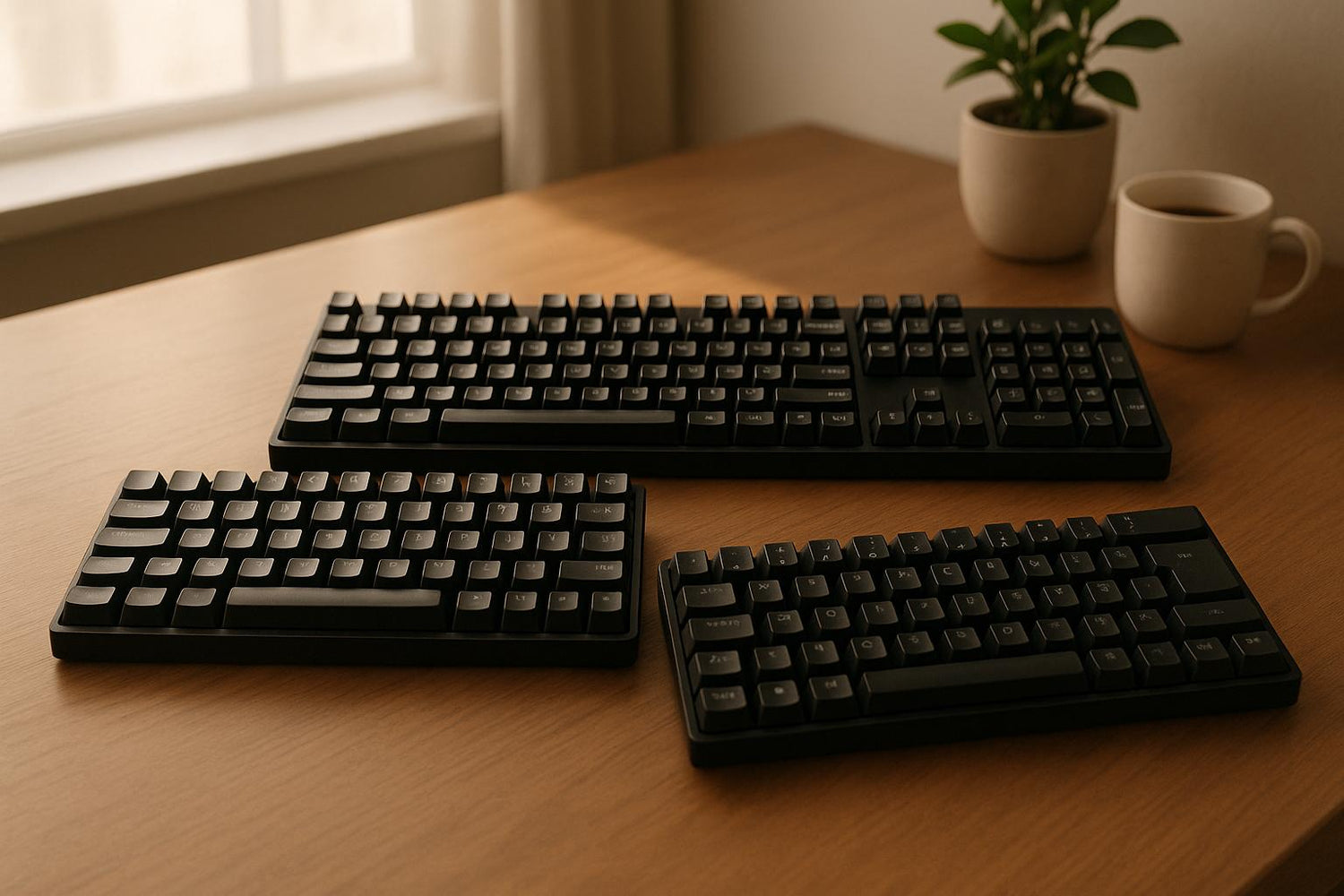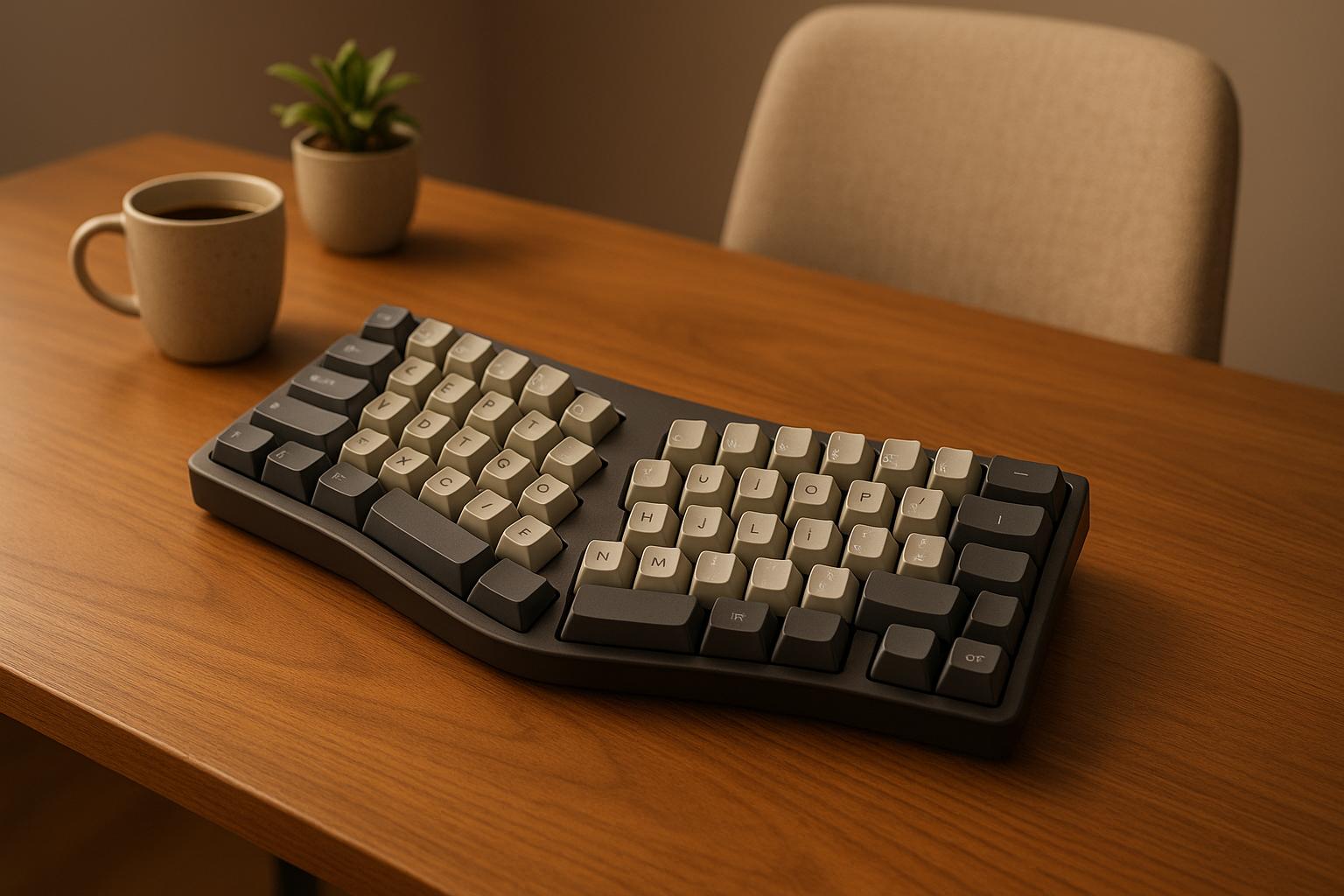Choosing the right keyboard size is all about balancing comfort, functionality, and workspace needs. Here's the quick breakdown:
- Full-Size (100%): Includes everything - numpad, function keys, and arrow keys. Best for data-heavy tasks like spreadsheets. Takes up the most space.
- Tenkeyless (TKL, 87%): Drops the numpad, saving desk space. Great for general typing and gaming.
- Compact Sizes (75%, 65%, 60%): Smaller layouts for portability and minimal desk use. Perfect for tight spaces or frequent travel.
Key Factors to Consider:
- Typing Habits: Do you need a numpad or function keys? Smaller keyboards may require shortcuts for these.
- Desk Space: Measure your desk and consider how much room you need for a mouse or other items.
- Portability: Smaller keyboards are easier to carry but may sacrifice some functionality.
Quick Tip: If you're unsure, start with a TKL or 75% keyboard - they offer a good balance of features and size. Now let’s dive into the details to help you decide what fits your needs best.
How to Choose the RIGHT Keyboard Size (60%, 65%, TKL, 100%)
Common Keyboard Sizes
Choosing the right keyboard size is all about finding the balance between functionality, desk space, and portability. Here's a closer look at the most common sizes and what they offer.
Full-Size (100%)
If you need all the bells and whistles, a full-size keyboard is the way to go. With around 104 keys (or 108 if multimedia keys are included), these keyboards provide the complete layout: alphanumeric keys, function keys, a full number pad, arrow keys, and special keys. Measuring roughly 17 inches (427.5 millimeters) in length, they do take up more desk space, but they’re perfect for professionals, gamers, and anyone who relies on extensive data input.
For gamers, the extra keys can be programmed for macros and commands, while office workers and writers benefit from the full range of keys for tasks like document editing. When shopping for a full-size keyboard, think about key switch types (mechanical or membrane), connectivity (wired or wireless), and additional features like backlighting or programmable keys.
Tenkeyless (TKL, 87%)
Tenkeyless keyboards are a compact alternative, ideal for users who don’t need a number pad. With 87 or 88 keys, these keyboards retain all the essential keys while shaving off the number pad, making them about 14–15 inches long. This smaller footprint not only saves space but also brings your mouse closer, which can reduce wrist and shoulder strain during long sessions.
TKL keyboards shine in gaming, particularly for FPS, MMO, or MOBA titles, where extra mouse space can make a big difference. They’re also great for programming and general use, though they may not be the best fit if you frequently work with numbers.
Compact Sizes (75%, 65%, and 60%)
Compact keyboards are all about portability and conserving desk space, offering creative layouts to keep essential keys within reach.
- 75% keyboards keep both function keys and arrow keys but reduce the spacing between key clusters. This layout is a smart choice for users who rely on function keys for shortcuts but still want to save space.
- 65% keyboards drop the function row but retain dedicated arrow keys and navigation keys. This setup strikes a balance between being compact and retaining usability, especially for tasks requiring frequent navigation.
- 60% keyboards take minimalism to the next level by removing the function row, number pad, and arrow keys altogether. Accessing these features requires key combinations, which can take some getting used to but allows for the smallest and most portable design.
Each of these compact options caters to different needs. If portability is a top priority, 60% keyboards are the easiest to travel with. On the other hand, 65% and 75% layouts offer more dedicated keys while still saving space. Your choice ultimately depends on how comfortable you are with using key combinations versus having dedicated keys.
Factors to Consider When Choosing a Keyboard Size
Picking the right keyboard size isn't just about how it looks on your desk. Your daily routines, workspace constraints, and personal preferences all play a major role in deciding which size fits you best. Let’s dive into the main factors to help guide your choice.
Typing Habits and Workflows
Your typing patterns are a big factor in choosing a keyboard. If you rarely use a numeric keypad, you might prefer a smaller keyboard paired with a standalone numpad for occasional use.
For programmers, TKL (tenkeyless) or smaller keyboards are often the go-to choice. These layouts bring shortcut keys and coding functions closer, minimizing hand movement during long hours of work. Gamers, on the other hand, frequently lean toward TKL or 60% keyboards. The compact size leaves more room for mouse movement, which can be a game-changer in competitive settings.
Your specific workflow also matters. If you frequently use function keys for shortcuts, a 75% keyboard might strike the perfect balance - keeping those keys while saving desk space. On the flip side, if you're comfortable using layered functions, smaller keyboards can help create a more streamlined setup.
Take some time to observe your key usage over a week. This will help you identify keys you don’t use and determine the layout that best matches your needs.
Desk Space and Portability
Your desk setup is another key consideration. Before you commit to a keyboard, measure your available workspace. Full-size keyboards take up more room, while compact models are designed to save space on crowded desks. Compact keyboards - those around 14 inches wide or smaller - can also improve ergonomics by reducing the distance between your keyboard and mouse, which may help reduce wrist and shoulder strain during long sessions.
Portability is essential for those who travel often or work in multiple locations. A 75% keyboard strikes a nice balance here. It’s smaller than a TKL but still includes essential keys, making it easier to carry without sacrificing functionality. If your desk is tight on space or you’re juggling multiple monitors, switching from a full-size to a TKL keyboard can free up just enough room to make your workspace feel more organized and comfortable.
Customization and Aesthetics
Your keyboard’s customization potential and appearance can heavily influence your decision. Smaller keyboards often boast a sleek, minimalist aesthetic, while larger ones offer a more traditional and functional vibe. The look of your keyboard can set the tone for your entire workspace.
When it comes to customization, size plays a big role. If you're planning to modify your keyboard, opt for one that’s built with customization in mind. Many compact keyboards shine in this area, offering features like hot-swappable switches, compatibility with custom keycaps, and unique layouts.
Keycaps, in particular, can dramatically change both the look and feel of your keyboard. RGB lighting is another area where size matters - smaller boards often allow for intricate per-key lighting effects, color-coded zones, or dynamic visuals. Beyond lighting and keycaps, some customizable keyboards let you add personal touches like swappable accent pieces, rotary knobs, or vibrant coiled cables.
Aesthetics go beyond just looking good - they can enhance your workspace’s vibe and boost your efficiency. A minimalist 60% keyboard might perfectly complement a clean, modern setup, while a full-size RGB keyboard could be the centerpiece of a bold gaming station.
sbb-itb-3cb9615
Keyboard Size Comparison Table
Here's a breakdown of keyboard sizes to help you weigh the options and pick what works best for your needs:
| Keyboard Size | Width (approx.) | Key Features | Best For | Desk Space | Portability |
|---|---|---|---|---|---|
| Full-Size (100%) | 17–18 inches | Includes numpad, function keys, arrow keys, and home cluster | Ideal for data entry, spreadsheets, and office tasks | Takes up the most space | Least portable |
| Tenkeyless (TKL, 87%) | 14–15 inches | Function keys, arrow keys, and home cluster (no numpad) | Great for gaming, general typing, and versatile use | Frees up moderate desk space | Travel-friendly |
| 75% | 12–13 inches | Compact function keys and arrow keys | Perfect for programming and compact setups without sacrificing functionality | Small desk footprint | Easy to carry |
| 65% | 11–12 inches | Arrow keys with fewer dedicated keys | Suited for gaming and minimalist setups | Smaller footprint | Highly portable |
| 60% | 11–12 inches | Stripped-down layout with a function layer for extra commands | Best for gaming and ultra-compact setups | Smallest footprint | Most portable |
One thing to note: 60% keyboards rely on a secondary function layer for additional commands. Their compact design can also bring your mouse closer, which might reduce arm strain during extended work or gaming sessions.
This table highlights how each size balances features, desk space, and portability, making it easier to choose the right fit for your workspace and lifestyle.
Step-by-Step Guide to Choosing the Right Keyboard Size
Now that we've covered the key factors to consider, here's a clear, step-by-step process to help you find the keyboard size that fits your needs. This guide will simplify your decision-making and ensure your choice aligns with your typing habits, workspace, and budget.
Step 1: Assess Your Key Usage
Start by examining your current keyboard to identify your most-used keys. Check for signs of wear - keys that are shiny, faded, or worn down often reveal your typing patterns.
"The three most used keys on a keyboard are Spacebar, e, BackSpace according to Microsoft".
Your usage patterns will vary depending on your activities. Gamers might notice wear on the WASD keys, while programmers often rely heavily on modifiers like Ctrl, Shift, or Alt. Typists may see wear on alphanumeric keys and the spacebar. The spacebar is typically the most used key, followed by the letter "E".
By identifying these patterns, you’ll have a better sense of which keys are essential for your workflow. This insight will guide you toward the right keyboard layout and size.
Step 2: Measure Your Desk Space
Next, take a close look at your workspace. Measure the width and depth of your desk, factoring in the space needed for other essentials like a mouse, monitor, or notebook. Be realistic about the usable area - it's not just about squeezing the keyboard in but ensuring enough room for comfort and productivity.
If your desk has an irregular shape, break it into smaller sections and measure each part to get an accurate sense of available space. Keep ergonomics in mind, too - a properly sized keyboard should allow your wrists to stay straight and your shoulders relaxed while typing.
Once you have these measurements, you’ll be ready to match your workspace needs with your budget and style preferences.
Step 3: Balance Budget and Features
Finally, consider your budget alongside your preferences. Mechanical keyboards are a popular choice for their durability and typing experience, though their upfront cost can vary widely.
- Entry-level mechanical keyboards often start around $100.
- Mid-range options with better materials and features fall between $200 and $300.
- High-end custom builds can go beyond $500.
Focus on features that matter most, like quality switches, which have a significant impact on your typing experience. Avoid spending extra on features you won’t use - prioritize essentials like durability and customization options.
For a range of options, check out retailers like KeebsForAll, which offers keyboards across all sizes and price points. Whether you're a first-time buyer looking for budget-friendly components or an enthusiast chasing premium aesthetics and performance, there's something for everyone.
Before making your final decision, do your homework. Read reviews, compare models, and consider how the keyboard fits into your daily routine. A well-chosen keyboard isn’t just a purchase - it’s an investment in comfort and efficiency for years to come.
Finding Your Perfect Keyboard Size
Now that you’ve done your research, it’s time to narrow down your options. Reflect on the three key factors: how you’ll use the keyboard, the space available on your desk, and your budget. These elements together will point you toward the keyboard size that fits your needs best.
Once you’ve assessed your priorities, focus on layouts that blend functionality and style. If you’re still unsure, consider 75% or 80% keyboards. These layouts hit a sweet spot - they keep most essential keys while saving desk space, making them a practical choice for anyone who wants functionality without the heft of a full-size keyboard.
Your typing habits can also guide your decision. For example:
- Data entry professionals will appreciate the convenience of a full-size keyboard with a dedicated number pad.
- Gamers often prefer 60% keyboards, which free up plenty of space for mouse movement.
- Keyboard enthusiasts might lean toward TKL (tenkeyless) models, which balance features and portability.
Compact keyboards offer more than just space-saving benefits. They can help reduce physical strain by encouraging a natural hand position and providing more room for your mouse. A smaller keyboard - around 14 inches wide - can minimize overreaching and give you greater flexibility when arranging your workspace.
If you need a number pad but want to stick with a compact layout, consider adding a standalone numeric keypad. With these insights, you’ll be ready to explore options that match your preferences.
For instance, KeebsForAll offers a variety of mechanical keyboards tailored to different needs. Their Freebird series includes compact 60% models starting at $160 and full TKL options priced at $249.99. Both feature CNC aluminum cases and hot-swappable switches, making them a reliable choice for travel or professional use.
One final tip: the keyboard size you choose affects how many keys are directly accessible versus those requiring key combinations. Pick a size that complements your daily tasks, helping you stay productive while optimizing your workspace and budget.
FAQs
What are the benefits of using a tenkeyless (TKL) keyboard instead of a full-size keyboard?
A tenkeyless (TKL) keyboard comes with a handful of perks that make it stand out from a full-size keyboard. For starters, it takes up less room on your desk, making it perfect for tight spaces or those who prefer a clean, minimalist workspace. On top of that, its smaller size lets you keep your mouse closer to the keyboard, which can be easier on your shoulders and arms - great for long hours of use. And as a bonus, TKL keyboards are easier to carry around and have a sleek, uncluttered look that many users love.
How do smaller keyboard sizes like 60% or 65% affect typing comfort and efficiency?
Smaller keyboards, like 60% or 65% layouts, can make typing more efficient by cutting down on finger movement. This can lead to faster, more comfortable typing sessions. Plus, their compact design is perfect for smaller desks or minimalist setups where space is at a premium.
That said, the trade-off for their size is the removal or relocation of certain keys, such as function keys or the number pad. Accessing these often requires additional key combinations, which might take some getting used to. Depending on your typing habits and how often you rely on those keys, this adjustment could affect your comfort or productivity. Before opting for a compact keyboard, it’s worth considering how critical those extra keys are to your workflow and whether you're ready to adapt to a smaller layout.
What should I look for in a keyboard that’s portable but still great for work and gaming?
If you're looking for a keyboard that combines portability with functionality, compact options like Tenkeyless (TKL) or 75% layouts are worth considering. These designs help you save desk space while keeping all the essential keys you need for work or gaming.
For gaming enthusiasts, a keyboard with mechanical switches is a smart choice. They offer quicker response times and are built to last. If you’re often on the move, wireless connectivity can make your setup more convenient. And don’t overlook an ergonomic design - it’s crucial for staying comfortable during extended work or gaming marathons.



![[Pre-Order] Autumn Leaves PBT Keycaps - KeebsForAll](http://keebsforall.com/cdn/shop/products/DSC09732.jpg?v=1676148273)






Leave a comment
This site is protected by hCaptcha and the hCaptcha Privacy Policy and Terms of Service apply.